By Steven Ross Smith
Surface Tension
by Derek Beaulieu
Coach House Press (2022)
Following on and expanding upon the appearance and evolution of concrete poetry, which exploded language’s visual and representational potential in the 1950s, Derek Beaulieu’s Surface Tension captures, in a small square book – à la Bob Cobbing’s bill jubobe, also from Coach House (1976) – sets of stirred and swimming lettristic images. In nine discrete sequences, Beaulieu’s language elements – its letters, its surfaces – are rendered in swirls, grids, clusters, and trailings, using Letraset – that plastic dry-transfer tool with many fonts, launched in the ‘60s and used by hobbyists, advertisers, punks, and soon taken up by writers and artists in the concrete movement. For Beaulieu, Letraset has become his fetish material, his clay. He further manipulates the symbols using the photocopier to create and capture motion.
Surface Tension presents, interspersed with Derek’s ‘designs,’ five mini essays that elucidate his aesthetics and offer musings on the state and possibilities of poetry. Statements like “Poets don’t own their work; they just borrow it from the dictionary” stir a chuckle and provoke thought about language – be it in its striving for social meaning, liminality, retail messaging – or in Concretist mode, its presentation as object.
A fun example is the sequence “Ampersandance” (the title itself a witty bit of wordplay). The 13 parts play with the ubiquitous symbol, the ampersand – & – morphing, angling, stretching, tangling, tangoing the glyph itself. The resulting figures and shapes are not metaphors, or Rorschach tests, but may represent or suggest, depending on the viewers’ sight or insight. Other pieces are more architectural, structured, boundaried, or decorative – and some letter patterns intensify as micro closeups. In any case, his manipulations are abstract, experiential events.
Speaking, as I did, of Bob Cobbing, there is an eleven-part “in memoriam“ sequence dedicated to the Brit artists and inspirers – Cobbing, his wife Jennifer, and collaborator Lawrence Upton – who published, created, and performed in the early days of poetic experimentation. The series is a turbulent, darkening, zoom-in. For the viewer it may invite personal interpretations, as sometimes happens, even with abstraction; it might be singing, it might be grief, though association is unnecessary. The suite simply ‘is,’ and is fitting. As Beaulieu says in one essay “A poem should not mean / but be.”
Oddly enough, the book begins – in its very first pages – with praising testimonials from four writers and critics, icons of the creative avant-garde – among them Americans Marjorie Perloff and Craig Dworkin – setting a stage for the poet’s poems and commentaries, which in my mind – and it seems in Beaulieu’s – ought to stand for themselves. They should “be,” before being described, or validated; if such appears, it is more suitable in an afterword, or in a review such as this.
In Surface Tension, the symbolic material of language – letter shapes – float, pool, dance, swim, jag, and jiggle. Imagine all that labour, the poet rubbing, twisting, thinking – the creative act, intuitive and structured, made physical. Letters become a substance reclaimed and reimagined, stretching a history of twentieth-century commerce and of earlier script, glyph, and rock scraping. It is writing, music, movement, vision, imagination, communication – and poetry – and is most engaging at that.
Steven Ross Smith is a Canadian poet, sound poet, fiction writer, arts journalist, and arts activist. He is best known for his fluttertongue poems, which have been published in six volumes. One of them, fluttertongue 3: disarray, won the 2005 Book of the Year Award at the Saskatchewan Book Awards.
